

For decades, our investment experts have been designing portfolios using a multi-manager approach to help investors achieve their goals. MLC Asset Management’s investment team pioneered the multi-manager investment model in Australia over 35 years ago and IOOF’s team has received numerous industry awards for their multi-manager expertise.
The coming together of the investment teams of IOOF, MLC and ANZ Pensions and Investments, under the MLC Asset Management banner, has increased the depth and breadth of investment experience, knowledge, and resources working for our clients, and magnified our expertise in multi-manager investing.
Today we are proud to be one of Australia’s largest investment managers with over $148 billion* in assets under management. Our focus is to provide our clients with a contemporary range of high conviction, best-in-class, investment strategies and we have more than 45 investment professionals** applying their experience, knowledge and judgement to deliver consistent performance for our clients.
These beliefs guide our decision making and are central to how we construct our portfolios and bring the best of our investment thinking to our clients.
We believe:
Our Chief Investment Officer, Dan Farmer, explains our Investment Philosophy.

The principle of saving is well known. Money is put away in a savings account or term deposit, generally achieving a fixed rate of interest with minimal risk.
Unfortunately, a savings account can offer returns little better than inflation. In real terms, that means you may end up losing money on your initial investment.
Investing, on the other hand, is the commitment of money today which, with an appropriate level of risk, comes with the expectation of realising your future financial goals.
It's about making your money work harder for you than just saving alone can!
This guide aims to build your understanding of the fundamentals of investing and helps get you started on the path to securing your financial independence.

Asset classes are different investment categories and are the building blocks of an investment. The main asset classes are shares, property, fixed interest and cash.
Australian shares are shares in companies listed on Australian stock exchanges. Shares or stocks are securities representing ownership in a company. When companies distribute profits (via dividends), the investor receives part of it and often Australian companies partially or fully pay the tax payable on company income (franking).
Global shares are shares listed on international stock exchanges. Global shares can have the additional risk of movements in the value of the Australian dollar against foreign currencies. Changes in exchange rates will change the Australian dollar value of Global shares. Fund managers can use strategies called derivatives to ‘manage’ investments against adverse currency movements.
Property can include investments in listed property trusts (LPT) and other property securities. LPTs invest in a range of residential and commercial property, office buildings, hotels and industrial properties. LPTs are pooled property investments which are broken into units and listed on the stock exchange like shares in a company.
A fixed interest investment is a debt security issued by a bank, corporation or government in return for cash from an investor. The issuer of the debt is effectively a borrower and is required to pay interest on the loan for the life of the security. Fixed interest investments are valued on a mark to market basis, and as a result, their value may fluctuate. Fixed interest investments are generally higher risk than cash but lower risk than shares and property.
Cash funds are designed to offer a high degree of capital security relative to other asset classes. Generally, cash investments have a very low risk of capital loss. Examples include bank deposits and investments in fixed interest securities, including treasury notes and highly rated corporate debt securities which generally have a maturity of less than one year.
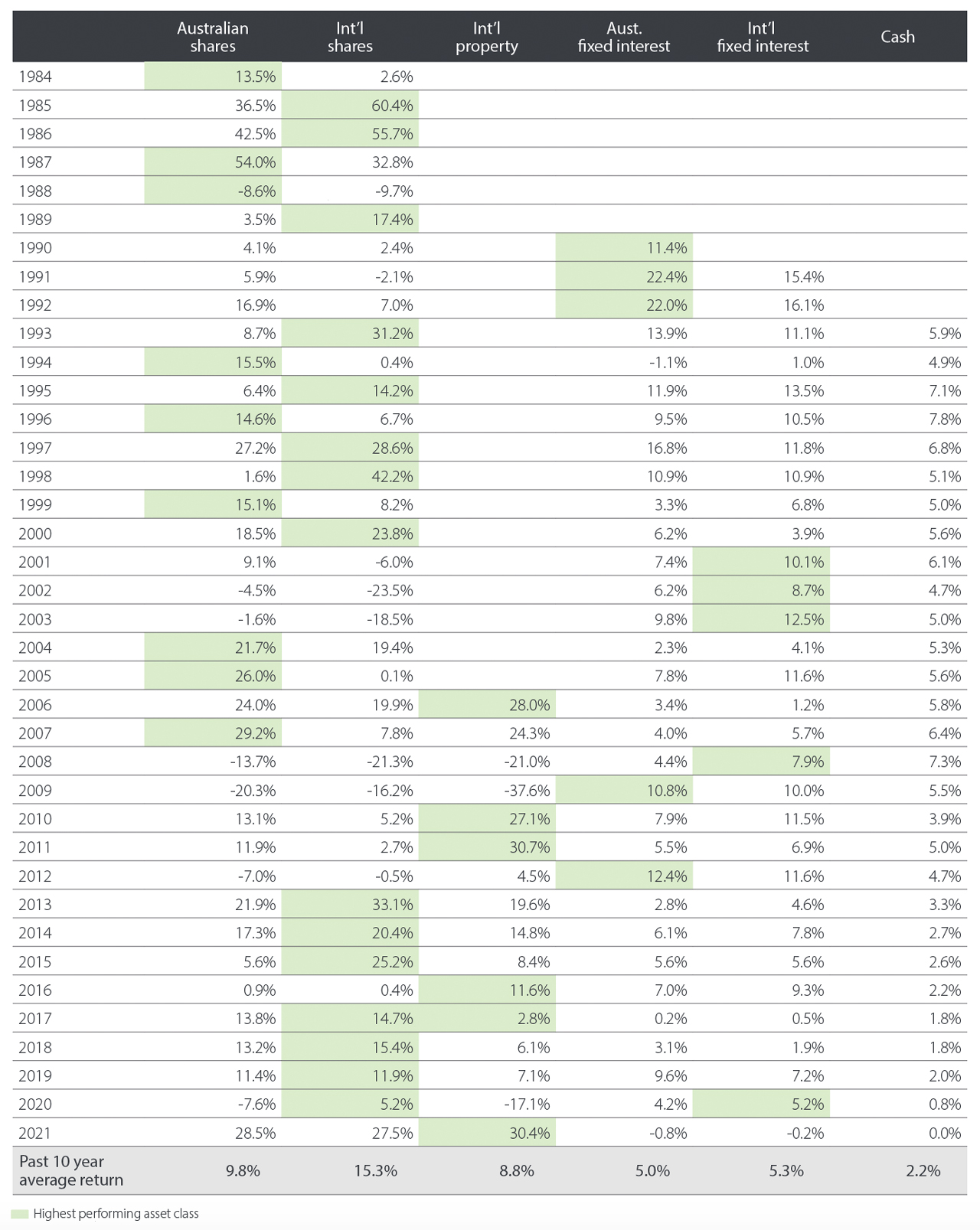
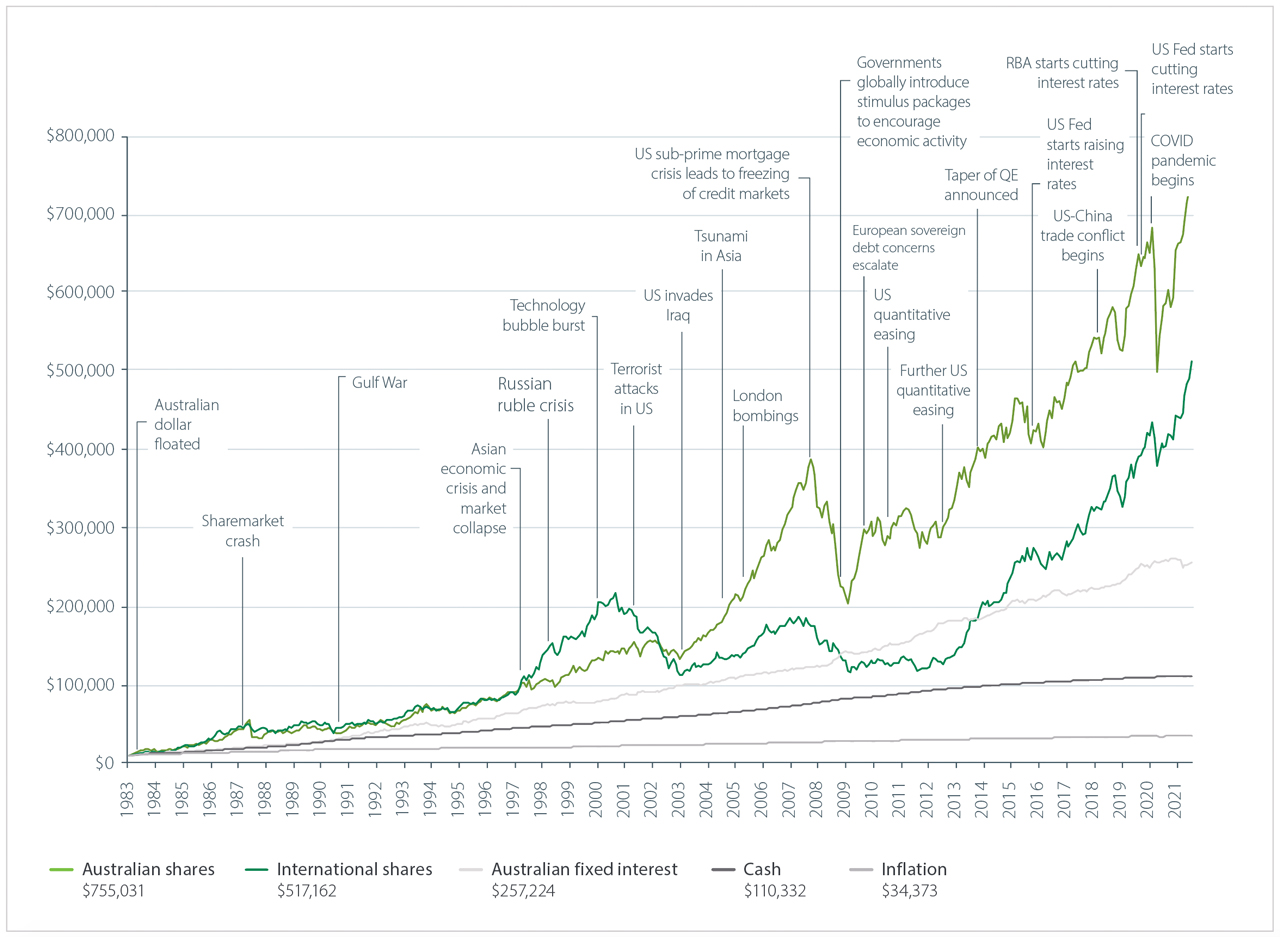
^Timeframe: 1 July 1983 to 30 June 2021.
#Timeframe: 1 January 1983 to 30 June 2021. Past performance is not indicative of future performance. Your investment is subject to investment risk, including possible repayment delays and loss of income and capital invested. Any case study is shown for illustrative purposes only and is not a prediction of the actual outcomes you will achieve. Listed real assets and international fixed interest are not included in the graph above because data is not available from 1983.
Source: FactSet.
Data: Australian shares: S&P/ASX 300 Total Return Index | Global shares: MSCI World (ex Aust) Net Total Return Index in AUD | International listed property trusts: FTSE EPRA NAREIT (ex Aust) Total Return Index hedged to AUD | Australian fixed interest: Bloomberg AusBond Composite 0+ Years | International fixed interest: Bloomberg Barclays Global Aggregate hedged in AUD | Cash: Bloomberg Ausbond Bank Bill Index | Inflation: Consumer Price Index.
Note: Alternative assets do not have a standardised index so have not been included in the table or graph.
Important Information: This document is issued by IOOF Investment Services Ltd (IISL) ABN 80 007 350 405, AFSL 230703. IISL is a company within the IOOF Group which consists of IOOF Holdings Ltd ABN 49 100 103 722 and its related bodies corporate. This document contains factual information only and should not be relied on for decision making. This information in this document is based in part on information obtained in good faith from third party sources and is current as at September 2021. While this information is believed to be accurate and reliable at the time of publication, to the extent permitted by law, no liability is accepted for any loss or damage as a result of reliance upon it.

Part of any investment strategy involves determining the most appropriate asset allocation to meet your goals. The investment strategy that is most suitable for you is determined by a combination of factors, including your investor profile and your time horizon.
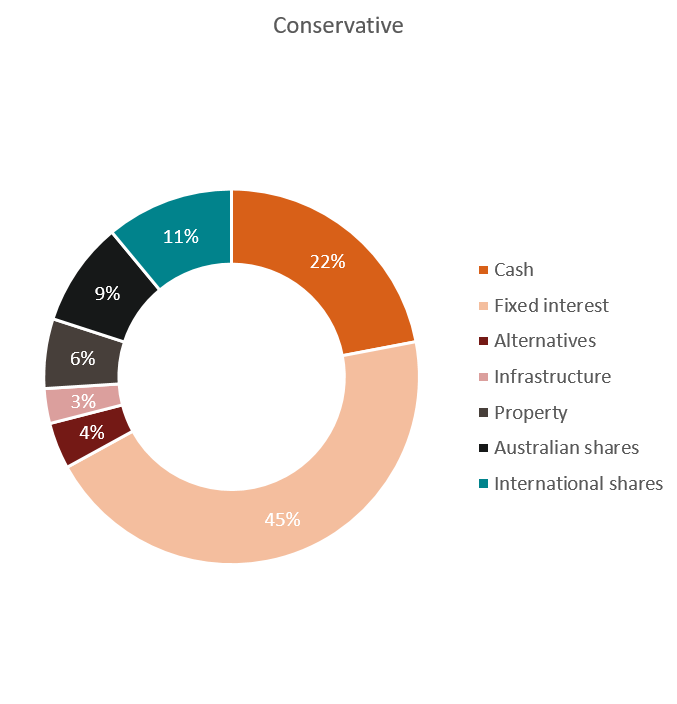



Please note these are sample profiles only of the MultiActive diversified funds – actual asset allocations may vary from fund to fund.
Growth of $10,000 over time*
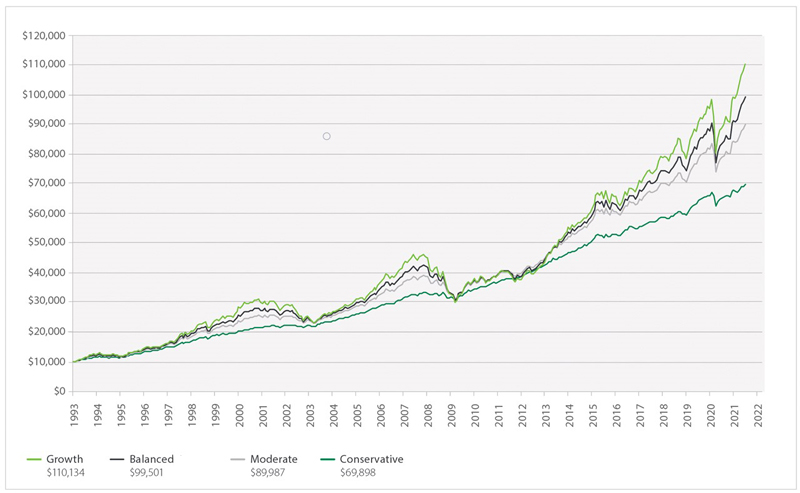
* Past performance is not indicative of future performance and the value of investments may rise or fall. This performance chart is based on our current strategic asset allocations and is for illustrative purposes only.
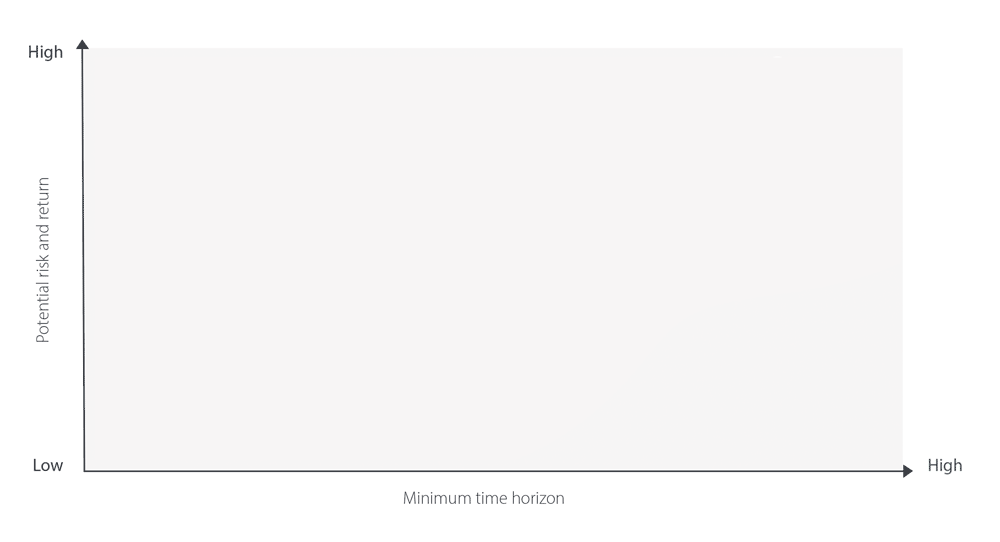
Timeframe: 1 January 1993 to 30 June 2021.
Source: FactSet.
Data: Australian shares: S&P/ASX 300 Total Return Index | Global shares: MSCI World (ex Aus) Net Total Return 30% Hedged to AUD | Listed real assets & unlisted assets: Pre 31/12/2005 MSCI World ex Australia Net Total Return 30% Hedged to AUD. Post 31/12/2005 50% FTSE EPRA/NAREIT Developed Rental Index ex Australia NR Hedged to AUD, 50% FTSE Developed Core Infrastructure 50/50 NR Hedged to AUD | Alternative growth: HFRI Fund of Fund Index, HFRI Fund of Fund Index Hedged to AUD from 31/12/2019 | Alternative defensive: Bloomberg AusBond Composite Bond Index 0-3 Years | Fixed interest: 50% Bloomberg AusBond Composite Bond Index 0+ Years and 50% Barclays Global Aggregate Hedged to AUD | Cash: Bloomberg Ausbond Bank Bill Index.
Important Information: This document is issued by IOOF Investment Services Ltd (IISL) ABN 80 007 350 405, AFSL 230703. IISL is a company within the IOOF Group which consists of IOOF Holdings Ltd ABN 49 100 103 722 and its related bodies corporate. This document contains factual information only and should not be relied on for decision making. This information in this document is based in part on information obtained in good faith from third party sources and is current as at September 2021. While this information is believed to be accurate and reliable at the time of publication, to the extent permitted by law, no liability is accepted for any loss or damage as a result of reliance upon it.
Impact of world events on investment markets
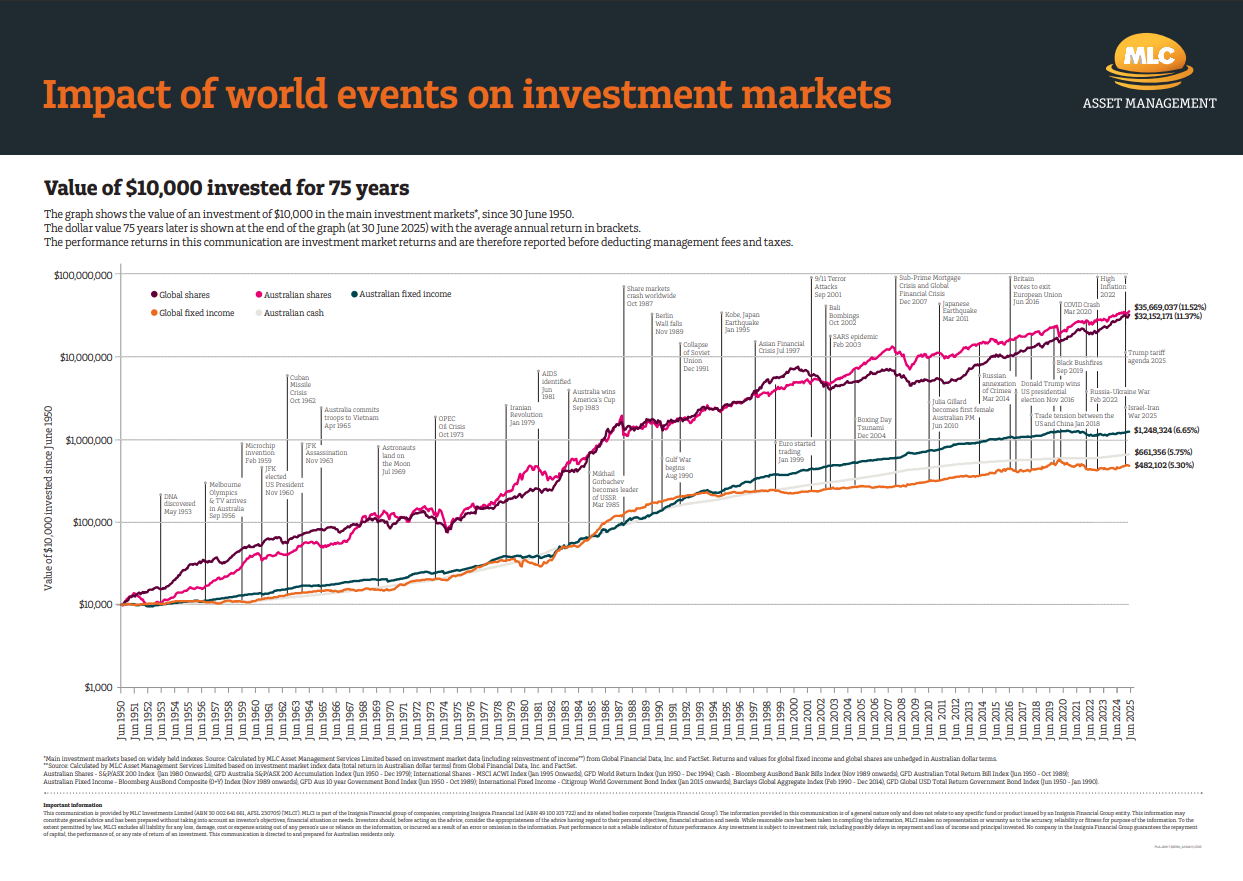
While market cycles come and go, investing in Australian shares has consistently delivered positive returns over the long term. Historical data—spanning both 40 years and 125 years—shows the strength of long-term investing in Australian equities.


Illustrating the effects of Bull and Bear markets on local investments over the past 45 years
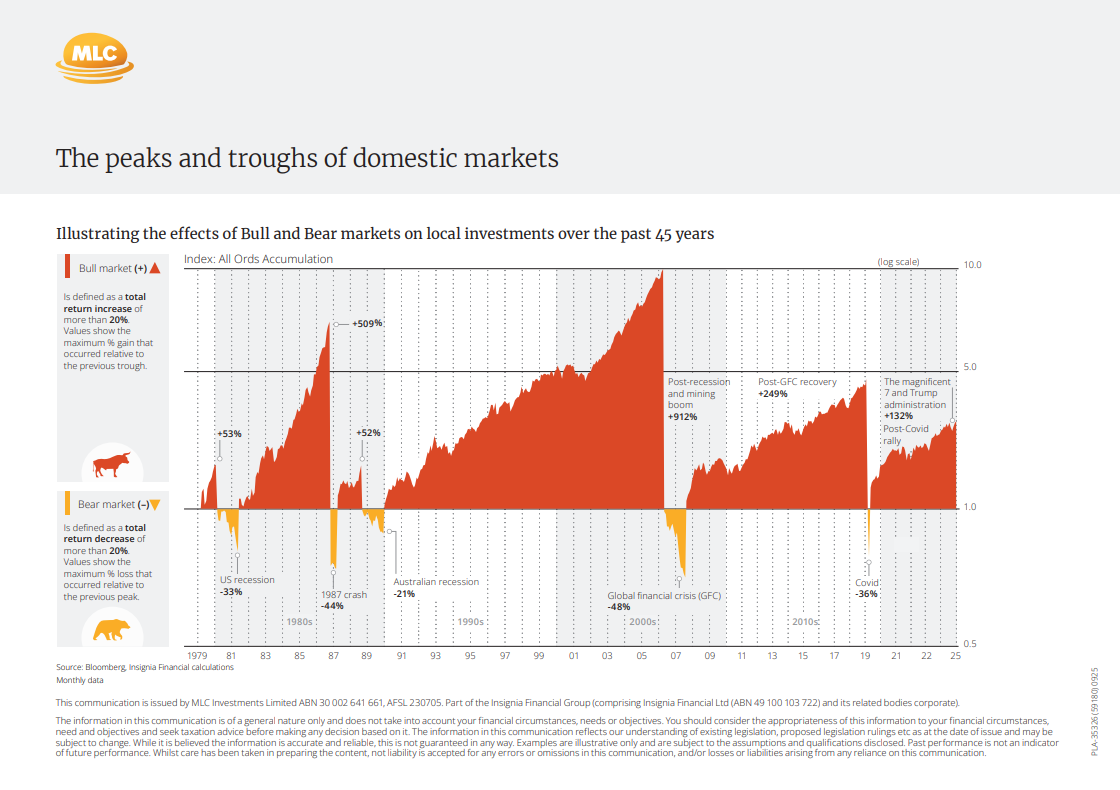
Illustrating the effects of Bull and Bear markets on global investments over the past 55 years
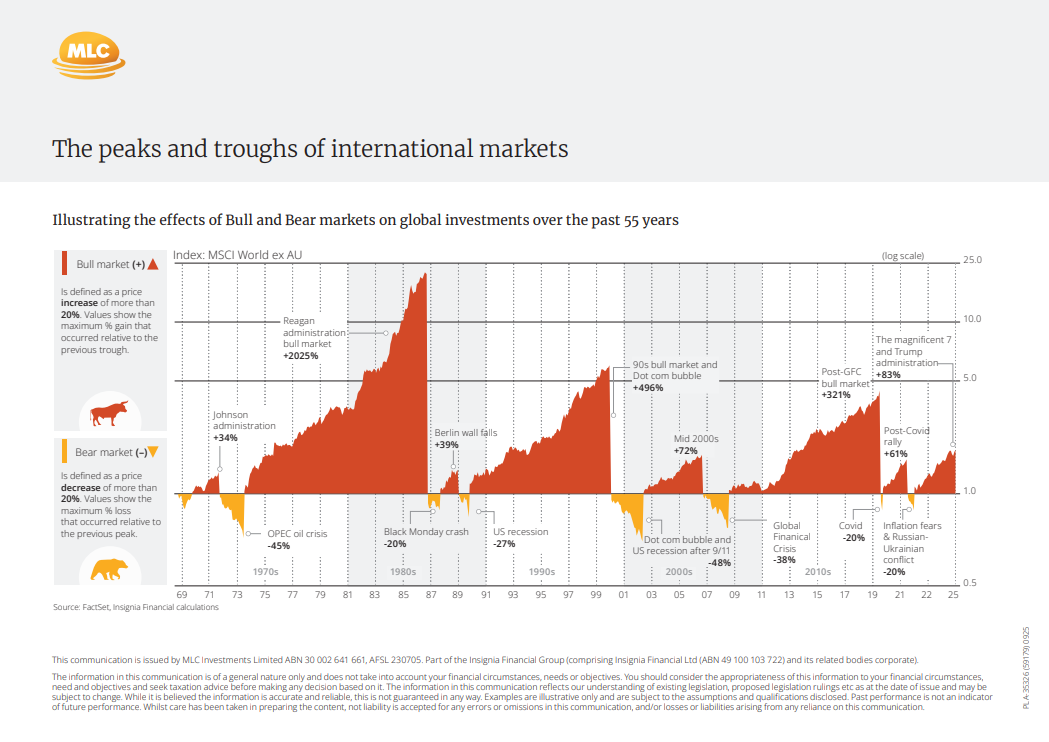
Responsible investment is the practice of considering Environmental, Social and Governance (ESG) factors in the research, analysis, selection and management of investments and the implementation of good stewardship practices.
There are a broad range of ESG factors that may impact the risk profile and or return characteristics of an investment. Some examples include:
| Environmental (E) | Social (S) | Governance (G) |
|---|---|---|
| Climate change initiatives like reduction in greenhouse gas emissions | Human capital management | Rights, responsibilities and expectations across all stakeholders |
| Waste management | Labour standards | Board structure, diversity and independence |
| Energy efficiency | Modern slavery | Executive remuneration (short- and long-term incentives) |
| Water supply | Diversity, Equity and Inclusion (DE&I) | Bribery and corruption |
| Pollution | Workplace health and safety | Anti-competitive behaviour |
| Biodiversity | Integration with local community and earning a social licence to operate | Political lobbying and donations |
| Indigenous rights | Shareholder rights | |
| Employee engagement | Tax strategy |
Our Responsible Investment Statement defines the role Responsible Investment plays in the assessment, selection and monitoring process of externally appointed managers and outlines the framework for identifying and managing Environmental, Social and Governance (ESG) risks and opportunities across a number of Managed Investment Schemes. This Policy covers IOOF Investment Services Limited (IISL) where it acts as a Responsible Entity/trustee of a managed investment scheme.

This communication is provided by MLC Investments Limited (ABN 30 002 641 661, AFSL 230705) (MLCI) and IOOF Investment Service Limited (ABN 80 007 350 405, AFSL 230703) (IISL). Both MLC and IISL are part of the Insignia Financial Group of companies (comprising Insignia Financial Ltd, ABN 49 100 103 722 and its related bodies corporate) ('Insignia Financial Group'). An investment with MLCI or IISL does not represent a deposit or liability of, and is not guaranteed by, the Insignia Financial Group.
This information may constitute general advice. It has been prepared without taking account of an investor's objectives, financial situation or needs and because of that an investor should, before acting on the advice, consider the appropriateness of the advice having regard to their personal objectives, financial situation and needs. Past performance is not a reliable indicator of future performance. Share market returns are all in local currency. Any opinions expressed in this communication constitute our judgement at the time of issue and are subject to change. We believe that the information contained in this communication is correct and that any estimates, opinions, conclusions or recommendations are reasonably held or made as at the time of compilation. However, no warranty is made as to their accuracy or reliability (which may change without notice), or other information contained in this communication.
This information is directed to and prepared for Australian residents only.
MLCI or IISL may use the services of any member of the Insignia Financial Group where it makes good business sense to do so and will benefit customers. Amounts paid for these services are always negotiated on an arm's length basis. MLCI and IISL rely on third parties to provide certain information and is not responsible for its accuracy, nor is MLCI nor IISL liable for any loss arising from a person relying on information provided by third parties. Bloomberg Finance L.P. and its affiliates (collectively, "Bloomberg") do not approve or endorse any information included in this material and disclaim all liability for any loss or damage of any kind arising out of the use of all or any part of this material.
The funds referred to herein is not sponsored, endorsed, or promoted by MSCI or IISL, and neither MSCI or IISL bear liability with respect to any such funds.
These beliefs guide our decision making and are central to how we construct our portfolios and bring the best of our investment thinking to our clients.
We believe:
Our Chief Investment Officer, Dan Farmer, explains our Investment Philosophy.
MLC multi-manager funds
MLC managed account strategies
Our unified team has had a long association with creating and managing multi-manager portfolios for investors and draws on the very best of our individual corporate heritages, honed over multiple investment cycles. We have created an investment capability of significant depth and breadth in the industry – leveraging a powerful common engine room working for the benefit of our clients.

The principle of saving is well known. Money is put away in a savings account or term deposit, generally achieving a fixed rate of interest with minimal risk.
Unfortunately, a savings account can offer returns little better than inflation. In real terms, that means you may end up losing money on your initial investment.
Investing, on the other hand, is the commitment of money today which, with an appropriate level of risk, comes with the expectation of realising your future financial goals.
It's about making your money work harder for you than just saving alone can!
This guide aims to build your understanding of the fundamentals of investing and helps get you started on the path to securing your financial independence.

Asset classes are different investment categories and are the building blocks of an investment. The main asset classes are shares, property, fixed interest and cash.
Australian shares are shares in companies listed on Australian stock exchanges. Shares or stocks are securities representing ownership in a company. When companies distribute profits (via dividends), the investor receives part of it and often Australian companies partially or fully pay the tax payable on company income (franking).
Global shares are shares listed on international stock exchanges. Global shares can have the additional risk of movements in the value of the Australian dollar against foreign currencies. Changes in exchange rates will change the Australian dollar value of Global shares. Fund managers can use strategies called derivatives to ‘manage’ investments against adverse currency movements.
Property can include investments in listed property trusts (LPT) and other property securities. LPTs invest in a range of residential and commercial property, office buildings, hotels and industrial properties. LPTs are pooled property investments which are broken into units and listed on the stock exchange like shares in a company.
A fixed interest investment is a debt security issued by a bank, corporation or government in return for cash from an investor. The issuer of the debt is effectively a borrower and is required to pay interest on the loan for the life of the security. Fixed interest investments are valued on a mark to market basis, and as a result, their value may fluctuate. Fixed interest investments are generally higher risk than cash but lower risk than shares and property.
Cash funds are designed to offer a high degree of capital security relative to other asset classes. Generally, cash investments have a very low risk of capital loss. Examples include bank deposits and investments in fixed interest securities, including treasury notes and highly rated corporate debt securities which generally have a maturity of less than one year.


^Timeframe: 1 July 1983 to 30 June 2021.
#Timeframe: 1 January 1983 to 30 June 2021. Past performance is not indicative of future performance. Your investment is subject to investment risk, including possible repayment delays and loss of income and capital invested. Any case study is shown for illustrative purposes only and is not a prediction of the actual outcomes you will achieve. Listed real assets and international fixed interest are not included in the graph above because data is not available from 1983.
Source: FactSet.
Data: Australian shares: S&P/ASX 300 Total Return Index | Global shares: MSCI World (ex Aust) Net Total Return Index in AUD | International listed property trusts: FTSE EPRA NAREIT (ex Aust) Total Return Index hedged to AUD | Australian fixed interest: Bloomberg AusBond Composite 0+ Years | International fixed interest: Bloomberg Barclays Global Aggregate hedged in AUD | Cash: Bloomberg Ausbond Bank Bill Index | Inflation: Consumer Price Index.
Note: Alternative assets do not have a standardised index so have not been included in the table or graph.
Important Information: This document is issued by IOOF Investment Services Ltd (IISL) ABN 80 007 350 405, AFSL 230703. IISL is a company within the IOOF Group which consists of IOOF Holdings Ltd ABN 49 100 103 722 and its related bodies corporate. This document contains factual information only and should not be relied on for decision making. This information in this document is based in part on information obtained in good faith from third party sources and is current as at September 2021. While this information is believed to be accurate and reliable at the time of publication, to the extent permitted by law, no liability is accepted for any loss or damage as a result of reliance upon it.

Part of any investment strategy involves determining the most appropriate asset allocation to meet your goals. The investment strategy that is most suitable for you is determined by a combination of factors, including your investor profile and your time horizon.




Please note these are sample profiles only of the MultiActive diversified funds – actual asset allocations may vary from fund to fund.
Growth of $10,000 over time*

* Past performance is not indicative of future performance and the value of investments may rise or fall. This performance chart is based on our current strategic asset allocations and is for illustrative purposes only.

Timeframe: 1 January 1993 to 30 June 2021.
Source: FactSet.
Data: Australian shares: S&P/ASX 300 Total Return Index | Global shares: MSCI World (ex Aus) Net Total Return 30% Hedged to AUD | Listed real assets & unlisted assets: Pre 31/12/2005 MSCI World ex Australia Net Total Return 30% Hedged to AUD. Post 31/12/2005 50% FTSE EPRA/NAREIT Developed Rental Index ex Australia NR Hedged to AUD, 50% FTSE Developed Core Infrastructure 50/50 NR Hedged to AUD | Alternative growth: HFRI Fund of Fund Index, HFRI Fund of Fund Index Hedged to AUD from 31/12/2019 | Alternative defensive: Bloomberg AusBond Composite Bond Index 0-3 Years | Fixed interest: 50% Bloomberg AusBond Composite Bond Index 0+ Years and 50% Barclays Global Aggregate Hedged to AUD | Cash: Bloomberg Ausbond Bank Bill Index.
Important Information: This document is issued by IOOF Investment Services Ltd (IISL) ABN 80 007 350 405, AFSL 230703. IISL is a company within the IOOF Group which consists of IOOF Holdings Ltd ABN 49 100 103 722 and its related bodies corporate. This document contains factual information only and should not be relied on for decision making. This information in this document is based in part on information obtained in good faith from third party sources and is current as at September 2021. While this information is believed to be accurate and reliable at the time of publication, to the extent permitted by law, no liability is accepted for any loss or damage as a result of reliance upon it.
Impact of world events on investment markets

While market cycles come and go, investing in Australian shares has consistently delivered positive returns over the long term. Historical data—spanning both 40 years and 125 years—shows the strength of long-term investing in Australian equities.


Illustrating the effects of Bull and Bear markets on local investments over the past 45 years

Illustrating the effects of Bull and Bear markets on global investments over the past 55 years

Responsible investment is the practice of considering Environmental, Social and Governance (ESG) factors in the research, analysis, selection and management of investments and the implementation of good stewardship practices.
There are a broad range of ESG factors that may impact the risk profile and or return characteristics of an investment. Some examples include:
| Environmental (E) | Social (S) | Governance (G) |
|---|---|---|
| Climate change initiatives like reduction in greenhouse gas emissions | Human capital management | Rights, responsibilities and expectations across all stakeholders |
| Waste management | Labour standards | Board structure, diversity and independence |
| Energy efficiency | Modern slavery | Executive remuneration (short- and long-term incentives) |
| Water supply | Diversity, Equity and Inclusion (DE&I) | Bribery and corruption |
| Pollution | Workplace health and safety | Anti-competitive behaviour |
| Biodiversity | Integration with local community and earning a social licence to operate | Political lobbying and donations |
| Indigenous rights | Shareholder rights | |
| Employee engagement | Tax strategy |
Our Responsible Investment Statement defines the role Responsible Investment plays in the assessment, selection and monitoring process of externally appointed managers and outlines the framework for identifying and managing Environmental, Social and Governance (ESG) risks and opportunities across a number of Managed Investment Schemes. This Policy covers IOOF Investment Services Limited (IISL) where it acts as a Responsible Entity/trustee of a managed investment scheme.

This communication is provided by MLC Investments Limited (ABN 30 002 641 661, AFSL 230705) (MLCI) and IOOF Investment Service Limited (ABN 80 007 350 405, AFSL 230703) (IISL). Both MLC and IISL are part of the Insignia Financial Group of companies (comprising Insignia Financial Ltd, ABN 49 100 103 722 and its related bodies corporate) ('Insignia Financial Group'). An investment with MLCI or IISL does not represent a deposit or liability of, and is not guaranteed by, the Insignia Financial Group.
This information may constitute general advice. It has been prepared without taking account of an investor's objectives, financial situation or needs and because of that an investor should, before acting on the advice, consider the appropriateness of the advice having regard to their personal objectives, financial situation and needs. Past performance is not a reliable indicator of future performance. Share market returns are all in local currency. Any opinions expressed in this communication constitute our judgement at the time of issue and are subject to change. We believe that the information contained in this communication is correct and that any estimates, opinions, conclusions or recommendations are reasonably held or made as at the time of compilation. However, no warranty is made as to their accuracy or reliability (which may change without notice), or other information contained in this communication.
This information is directed to and prepared for Australian residents only.
MLCI or IISL may use the services of any member of the Insignia Financial Group where it makes good business sense to do so and will benefit customers. Amounts paid for these services are always negotiated on an arm's length basis. MLCI and IISL rely on third parties to provide certain information and is not responsible for its accuracy, nor is MLCI nor IISL liable for any loss arising from a person relying on information provided by third parties. Bloomberg Finance L.P. and its affiliates (collectively, "Bloomberg") do not approve or endorse any information included in this material and disclaim all liability for any loss or damage of any kind arising out of the use of all or any part of this material.
The funds referred to herein is not sponsored, endorsed, or promoted by MSCI or IISL, and neither MSCI or IISL bear liability with respect to any such funds.
These beliefs guide our decision making and are central to how we construct our portfolios and bring the best of our investment thinking to our clients.
We believe:
Our Chief Investment Officer, Dan Farmer, explains our Investment Philosophy.
MLC multi-manager funds
MLC managed account strategies
Our unified team has had a long association with creating and managing multi-manager portfolios for investors and draws on the very best of our individual corporate heritages, honed over multiple investment cycles. We have created an investment capability of significant depth and breadth in the industry – leveraging a powerful common engine room working for the benefit of our clients.
Multi-manager fund solutions
Managed Account strategies